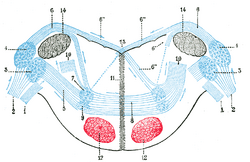Assessment |
Biopsychology |
Comparative |
Cognitive |
Developmental |
Language |
Individual differences |
Personality |
Philosophy |
Social |
Methods |
Statistics |
Clinical |
Educational |
Industrial |
Professional items |
World psychology |
Biological: Behavioural genetics · Evolutionary psychology · Neuroanatomy · Neurochemistry · Neuroendocrinology · Neuroscience · Psychoneuroimmunology · Physiological Psychology · Psychopharmacology (Index, Outline)
| Brain: Anterior cochlear nucleus | ||
|---|---|---|
| anterior cochlear nucleus is #3, at upper left | ||
| [[Image:|250px|center|]] | ||
| Latin | nucleus cochlearis anterior | |
| Gray's | subject #187 788 | |
| Part of | ||
| Components | ||
| Artery | ||
| Vein | ||
| BrainInfo/UW | hier-719 | |
| MeSH | [1] | |
The ventral cochlear nucleus (or anterior, or accessory ), placed between the two divisions of the cochlear nerve, is on the ventral aspect of the inferior peduncle. Composed of several regions of distinct cell types, this nucleus serves primarily as a relay station for ascending auditory information. Bushy cells in the anterior ventral cochlear nucleus (AVCN), which receive end bulbs of held from auditory nerve fibers, project to the superior olivary complex through the trapezoid body and intermediate acoustic stria. Other cell types project to the lateral lemniscus and the inferior colliculus directly.
Cell types[]
The VCN contains several cell types, which correspond fairly well with different physiological unit types. Additionally, these cell types generally have specific projection patterns.
Bushy Cells[]
Named due to the branching, tree-like, nature of their dentritic fields, visible using Golgi's method, receive large end bulbs of held from auditory nerve fibers. These cells can be further subdivided into spherical and globular types based upon their appearance in Nissl-stained material, and their location in the nucleus (anterior AVCN and posterior AVCN respectively).
Globular[]
Globular bushy cells project large axons to the contralateral MNTB where they synapse onto principal cells via a single calyx of held, and several smaller collaterals synapse ipsilaterally in the posterior (PPO) & dorsolateral periolivary (DLPO) nuclei, lateral superior olive (LSO), and lateral nucleus of the trapezoid body (LNTB); contralaterally in the dorsomedial periolivary nucleus (DMPO), ventral nucleus of the trapezoid body (VNTB), nucleus paragigantocellularis lateralis (PGL), and Ventral nucleus of the lateral lemniscus (VNLL). Axons always send a collateral into the MNTB, but do not necessarily give rise to collaterals that innervate each of the other nuclei.[1]
Spherical[]
Spherical bushy cells project ipsilaterally to the LSO, bilaterally to the Medial superior olive (MSO) and LNTB, and contralaterally to the VNTB and VNLL. The most important purpose of these projections seems to be to imbue the MSO and LSO with their interaural time and level sensitivities (respectively).[2]
Octopus cells[]
- Needs information added
Multipolar (Stellate) cells[]
- Needs information added
Anterior Ventral Cochlear Nucleus (AVCN)[]
- The AVCN can be subdivided based upon the cytoarchitecture of the region.
- Typical subdivisions are defined as: Anterior (AAVCN), Posterior(PAVCN), Posterodorsal (PDAVCN), and posteroventral (PVAVCN).[3]
- A well defined tonotopy is evident[4]. Lateral PVAVCN, Medial PVAVCN, and medial PDAVCN roughly correspond to the low (<1 kHz), middle (4-8 kHz), and high (>16 kHz) frequency regions defined by Bourk[3].
- The AVCN projects to nearly all brainstem auditory structures. High frequency regions tend to project to contralaterally, and low frequency regions bilaterally, preserving the tonotopic organization of the ascending auditory pathway[3].
- Stellate/multipolar cells form the projection to both inferior colliculi (central nucleus and dorsal cortex), and synapse in a banded pattern, following the tonotopy of the region[3].
Posterior Ventral Cochlear Nucleus (PVCN)[]
- Needs information added
References[]
- ↑ Smith, P. H., P. X. Joris, et al. (1991). "Projections of physiologically characterized globular bushy cell axons from the cochlear nucleus of the cat." J Comp Neurol 304(3): 387-407.
- ↑ Smith, P. H., P. X. Joris, et al. (1993). "Projections of physiologically characterized spherical bushy cell axons from the cochlear nucleus of the cat: evidence for delay lines to the medial superior olive." J Comp Neurol 331(2): 245-60.
- ↑ 3.0 3.1 3.2 3.3 Oliver, D. L. (1987). "Projections to the inferior colliculus from the anteroventral cochlear nucleus in the cat: possible substrates for binaural interaction." J Comp Neurol 264(1): 24-46.
- ↑ Bourk, T. R., J. P. Mielcarz, et al. (1981). "Tonotopic organization of the anteroventral cochlear nucleus of the cat." Hear Res 4(3-4): 215-41.
This article was originally based on an entry from a public domain edition of Gray's Anatomy. As such, some of the information contained herein may be outdated. Please edit the article if this is the case, and feel free to remove this notice when it is no longer relevant.
Auditory and vestibular pathways | ||||
|---|---|---|---|---|
| Auditory |
inner ear: Hair cells → Spiral ganglion → Cochlear nerve VIII → pons: Cochlear nuclei (Anterior, Dorsal) → Trapezoid body → Superior olivary nuclei → midbrain: Lateral lemniscus → Inferior colliculi → | |||
| Vestibular |
inner ear: Vestibular nerve VIII → pons: Vestibular nuclei (Medial vestibular nucleus, Lateral vestibular nucleus) cerebellum: Flocculonodular lobe spinal cord: Vestibulospinal tract (Medial vestibulospinal tract, Lateral vestibulospinal tract) | |||
| {| class="navbox collapsible nowraplinks" style="margin:auto; " | ||||
| ||||
|}
| This page uses Creative Commons Licensed content from Wikipedia (view authors). |
